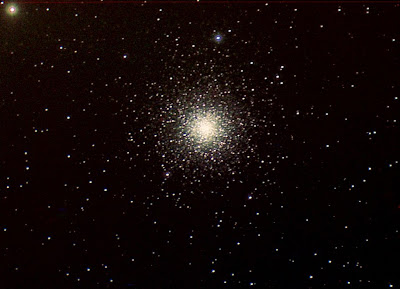 Click on image to enlarge.
Click on image to enlarge.Object: Messier 3 (NGC 5272)
Type: Globular Cluster
Distance: 34,000 light years
Distance: 34,000 light years
Constellation: Canes Venatici
Date: 26 May 2009
Equipment: SXV-H9, Vixen ED 114mm aperture f5.3 refractor, ATIK manual filter wheel, Astronomix LRGB filters
Subframes: 20 x 60 seconds luminance (2x2 binned), 20 X 40 seconds each for red, green and blue channels, 16 flats/flat darks in luminance only, calibrated and stacked in AIP4Win, tweaked in AstroArt and PSP7.
Equipment: SXV-H9, Vixen ED 114mm aperture f5.3 refractor, ATIK manual filter wheel, Astronomix LRGB filters
Subframes: 20 x 60 seconds luminance (2x2 binned), 20 X 40 seconds each for red, green and blue channels, 16 flats/flat darks in luminance only, calibrated and stacked in AIP4Win, tweaked in AstroArt and PSP7.
This session did not start particularly well. My venerable Skysensor 2000 GoTo unit has been getting increasingly cranky with age, rather like its owner. This time, when asked to point towards Regulus for initial alignment, the RA drive gave out a strange mewling noise and refused to move. Switching everything off and on again didn't help.
However, when I aimed at Vega as the initial alignment star, everything worked fine. Arcturus and Spica gave me my usual three star alignment in no time. Trying to return to Regulus prompted the drive to sulk again, however.
Regulus is a perfectly respectable star of course, and there was no need for this sort of behaviour. As the time was now around 11 pm though, and with clear and reasonably dark skies overhead, I really didn't want to spend any time fault-finding. Fortunately, when I aimed at M3, the image fell on the CCD chip first time. Tracking wasn't so good, though. The drive seemed a touch jittery and the best I could do was 60 second exposures, even with the PEC running.
Nevertheless this is plenty for a bright globular like M3, provided you don't want to image too deeply. I was interested in a wide field view and was reasonably satisfied with the final result as above, once I processed all of the images and layered them together.
It was certainly an improvement on my first attempt some five years earlier (see below).

I took this afocally with my (now sadly deceased) Casio QV-3500EX digital camera at the eyepiece of my VC200L. It's a single one-minute exposure at ISO400. It's interesting how the colour of this digital camera shot was reflected in the composite from the mono camera above - I have a routine I use for colour compositing in PSP7 and it does seem to match "reality" (subjective though that is when it comes to colours of deep sky objects) quite well.
Rob Gendler shows us what careful processing of top-class images of M3 can achieve here. He also gives us a stack of useful information about this object here.
Once I acquired the frames I wanted for M3, I thought I may as well stay up for another couple of hours and try and catch M5, possibly my favourite globular to look at visually. I don't know how those frames have turned out yet - rigor computoris is setting in and so they'll have to wait.



No comments:
Post a Comment